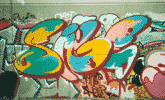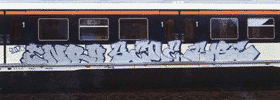
How did you start to write?
SIGE: "The movie "BEAT STREET" started it all. A
friend of mine invited me to watch the new movie which played
in the Bronx. This triggered the kick which incited me to refuse
what the others did and to rather look for something nobody
else did and which was also a bit mysterious.
Something like
Graffiti, which turned out to be the thing that immediately
turned me on.
In those days I lived in Steilshoop (part of the
city of HAMBURG). Shane became part of our group at a later
stage and he started in mid '87. We painted our first pieces
at school. At first all the teachers came along and judged it
was bad, since it was illegal. Still they thought it was rather
nice. This caused the issue to turn to the positive.
This positive
criticism turned out to be the decisive point. Somebody did
something, nobody knew anything about it and still everybody
thought it was ok. A few weeks later we painted the next piece
there and we got to know other people in Steilshoop and later
on, some people from Brahmfeld. We got to know Sene and others
when tagging in the underground trains.
They informed us that
there was a Writers Corner at Dammtor Railway station every
Thursday and invited us to join them. This was the point in
time where we spread our contacts to the other sprayers and
where we finally looked beyond our horizon."
How did you find your own style?
SIGE: "In the very beginning, the only orientation
were the moviess. Another orientation were the pieces here in
Hamburg, which were better than our own. The book "SUBWAY ART"
gave quite a few inspirations, origin of our own experiences,
but the results were not what seemed to be the essence.
Then
"SPRAY CAN ART" appeared with the pieces of BANDO and MODE 2
from Paris. I suddenly realised that this was the style which
appealed to me most for my future work. In fact, I preferred
the silver pieces. Watching only the style and avoiding thousands
of colours and copious designs. One colour, an outline and that
was it.
Paris was the idol which I had looked for and finally
found. There was a huge difference between Munich and Paris.
Munich bragged with its big, colourful and advanced walls. In
contrast to Paris, where you had styles with relatively simple
fill-ins. We had visited Paris in '89 for the exhibition of
FUTURA 2000. "
Did the trains tempt you also?
SIGE: "I believe that in my whole career, I did
not do more than 5 or 6 trains.

I was determined to concentrate on my own style and not to look
behind my back all the time, watching my piece with only one
eye. I also thought that the whole thing wasn't worthwile running
the risk of getting caught. To pay thousands of marks as a fine.
The spraying of a wall was more of a calculable risk than bombing
a train. 1988 was the hour of the "Graffiti squads" (Soko -
Sonderkom- mission Graffiti) of the local police, as opposed
to the security service of the railroad company."
How do you explain that at some stage you stopped painting
?
SIGE: "Graffiti for me took 25 hours a day. My only
goal in life. There was no free space for anything else. I had
started at the age of 17. After the Diebsteich project, the
end came about slowly.

During schooltime there were no other problems. But getting
older brought about a number of different thoughts about the
future. The ideal was to make a living out of the hobby. To
make enough out of Graffiti to earn daily life.
In '89 I tried
to obtain orders and positive publicity in a timid way. In those
days, everything concerning graffiti was reported in the most
negative way in the media. After the failure of the first attempts,
I decided to put the issue to rest. Obviously I fell into a
big deep black hole. What would happen, if I did not meet the
other sprayers again? What if I did not go out to spray during
the weekends?
Finally I looked for contacts with the old friends
and got back to the original career in which I really did not
want to end up again. I came to be a normal bourgeois who earns
his bucks in a normal job."
Do your fingers itch from time to time?
SIGE: "Sometimes I think about that, not for money's
sake but for the subject. But I never put these thoughts into
reality. I painted in fact, because it was fun, but to me Graffiti
is obviously art. The point was not in conveying any messages.
If I were 17 again, I would turn to Graffiti again, but at the
age of 25 I would not start again. I could not dump tie and
jacket and again take on the spray-can."
Did your parents know what you did?
SIGE: "My parents knew that I sprayed. But I explained
that I only did it legally. They accepted that, but advised
me not to do anything which would bring me into conflict with
the law."
Did you develop any interest in Hip-Hop at all?
SIGE: "I never wanted to start making music or to
dance.
The important thing to me was graffiti. That was the
part of hip-hop and my own way of finding my identity, the best
way of expressing myself.
Everyone has his own special strengths.
In fact I pursued one thing in an extreme way, really to the
point of excess. Spraying was the interesting thing about Hip-Hop.
It was the real illegal and dirty thing about it. The point
was to get into conflict with the law. You were the one who
went to school during daytime, who spent the afternoon at home,
made sketches and who set out in the evenings to paint.
It was
like Dr. Jekkyll and Mr. Hyde. Music or Breakdance was not extreme
enough to me."
Interview: m. reisser |